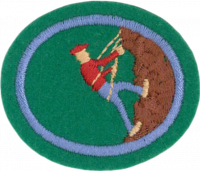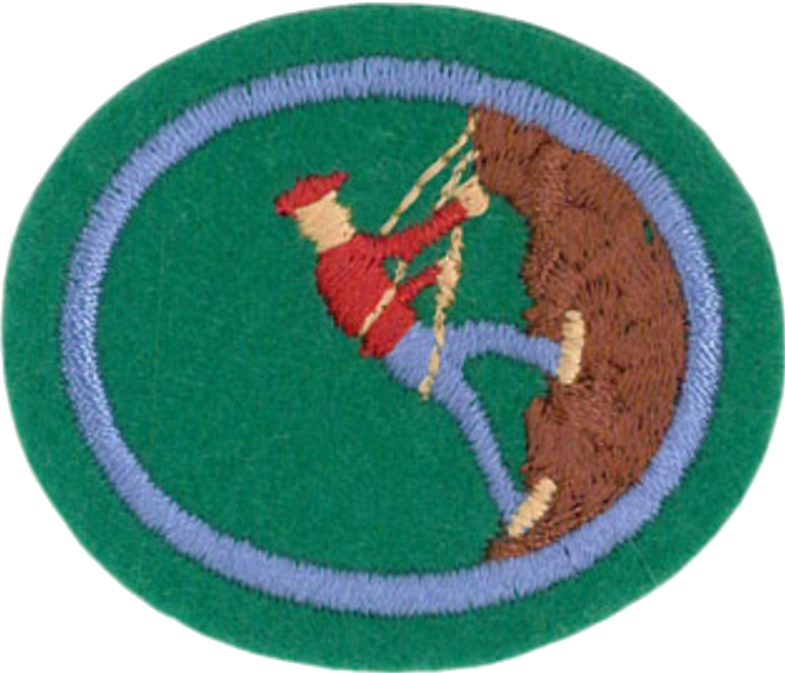Difference between revisions of "AY Honors/Rock Climbing/Requirements"
m (remove white space) |
(Marked this version for translation) |
||
| Line 3: | Line 3: | ||
<section begin=Body /> | <section begin=Body /> | ||
| − | <b>1. <section begin=req1 /><noinclude><translate></noinclude>Know and practice the safety precautions that should be followed while rock climbing. | + | <b>1. <section begin=req1 /><noinclude><translate><!--T:39--> |
| + | </noinclude>Know and practice the safety precautions that should be followed while rock climbing. | ||
<noinclude></translate></noinclude><section end=req1 /></b> | <noinclude></translate></noinclude><section end=req1 /></b> | ||
| − | <b>2. <section begin=req2 /><noinclude><translate></noinclude>Be familiar with and demonstrate the use of the following equipment: carabiners, pitons (various types), jam nuts (various types), runners, and nylon climbing rope. | + | <b>2. <section begin=req2 /><noinclude><translate><!--T:40--> |
| + | </noinclude>Be familiar with and demonstrate the use of the following equipment: carabiners, pitons (various types), jam nuts (various types), runners, and nylon climbing rope. | ||
<noinclude></translate></noinclude><section end=req2 /></b> | <noinclude></translate></noinclude><section end=req2 /></b> | ||
| − | <b>3. <section begin=req3 /><noinclude><translate></noinclude>Show how to care for and coil the climbing rope. Know how to tie and use the following knots: bowline on a coil, bowline on a bight, figure eight, ring bend, double fisherman's, and Prusik. | + | <b>3. <section begin=req3 /><noinclude><translate><!--T:41--> |
| + | </noinclude>Show how to care for and coil the climbing rope. Know how to tie and use the following knots: bowline on a coil, bowline on a bight, figure eight, ring bend, double fisherman's, and Prusik. | ||
<noinclude></translate></noinclude><section end=req3 /></b> | <noinclude></translate></noinclude><section end=req3 /></b> | ||
| − | <b>4. <section begin=req4 /><noinclude><translate></noinclude>Know when to rope up into a rope team and type of rope team movement for class three, four, and five climbing. | + | <b>4. <section begin=req4 /><noinclude><translate><!--T:42--> |
| + | </noinclude>Know when to rope up into a rope team and type of rope team movement for class three, four, and five climbing. | ||
<noinclude></translate></noinclude><section end=req4 /></b> | <noinclude></translate></noinclude><section end=req4 /></b> | ||
| − | <b>5. <section begin=req5 /><noinclude><translate></noinclude>Describe the six different classes of climbing and methods of rating climbs. | + | <b>5. <section begin=req5 /><noinclude><translate><!--T:43--> |
| + | </noinclude>Describe the six different classes of climbing and methods of rating climbs. | ||
<noinclude></translate></noinclude><section end=req5 /></b> | <noinclude></translate></noinclude><section end=req5 /></b> | ||
| − | <b>6. <section begin=req6 /><noinclude><translate></noinclude>Show how to static belay by belaying two climbers up in actual climbing. Show knowledge of proper body positions, braking surfaces, bracing and anchoring, and taking in the rope during the use of static belaying. | + | <b>6. <section begin=req6 /><noinclude><translate><!--T:44--> |
| + | </noinclude>Show how to static belay by belaying two climbers up in actual climbing. Show knowledge of proper body positions, braking surfaces, bracing and anchoring, and taking in the rope during the use of static belaying. | ||
<noinclude></translate></noinclude><section end=req6 /></b> | <noinclude></translate></noinclude><section end=req6 /></b> | ||
| − | <b>7. <section begin=req7 /><noinclude><translate></noinclude>Know and use the following climbing signals: belay on, climbing, climb, up rope, slack, tension, falling, rock, off belay, belay off, belay to point. | + | <b>7. <section begin=req7 /><noinclude><translate><!--T:45--> |
| + | </noinclude>Know and use the following climbing signals: belay on, climbing, climb, up rope, slack, tension, falling, rock, off belay, belay off, belay to point. | ||
<noinclude></translate></noinclude><section end=req7 /></b> | <noinclude></translate></noinclude><section end=req7 /></b> | ||
| − | <b>8. <section begin=req8 /><noinclude><translate></noinclude>Using Prusik knots and slings, ascend 25 feet (7.62 meters) of vertical rope. Show how to use mechanical ascending devices such as jumars, Gibbs ascenders, etc. | + | <b>8. <section begin=req8 /><noinclude><translate><!--T:46--> |
| + | </noinclude>Using Prusik knots and slings, ascend 25 feet (7.62 meters) of vertical rope. Show how to use mechanical ascending devices such as jumars, Gibbs ascenders, etc. | ||
<noinclude></translate></noinclude><section end=req8 /></b> | <noinclude></translate></noinclude><section end=req8 /></b> | ||
<section begin=challenge /> | <section begin=challenge /> | ||
| − | <b>9. <section begin=req9 /><noinclude><translate></noinclude>Properly free climb up to 5.3 (F3) difficulty on two different pitches a distance of at least 50 feet (15.24 meters) with an upper belay. Understand and practice the following free climbing concepts: rhythm, looking ahead, weight over the feet, balance climbing, counterforce climbing, and jamming. | + | <b>9. <section begin=req9 /><noinclude><translate><!--T:47--> |
| + | </noinclude>Properly free climb up to 5.3 (F3) difficulty on two different pitches a distance of at least 50 feet (15.24 meters) with an upper belay. Understand and practice the following free climbing concepts: rhythm, looking ahead, weight over the feet, balance climbing, counterforce climbing, and jamming. | ||
<noinclude></translate></noinclude><section end=req9 /></b> | <noinclude></translate></noinclude><section end=req9 /></b> | ||
<section end=challenge /> | <section end=challenge /> | ||
| − | <b>10. <section begin=req10 /><noinclude><translate></noinclude>Show how to set up a rappel. Rappel using figure eights or other mechanical brake methods. Do at least two 50-foot (15.24 meters) rappels. | + | <b>10. <section begin=req10 /><noinclude><translate><!--T:48--> |
| + | </noinclude>Show how to set up a rappel. Rappel using figure eights or other mechanical brake methods. Do at least two 50-foot (15.24 meters) rappels. | ||
<noinclude></translate></noinclude><section end=req10 /></b> | <noinclude></translate></noinclude><section end=req10 /></b> | ||
<section end=Body /> | <section end=Body /> | ||
<noinclude><translate> | <noinclude><translate> | ||
| + | <!--T:49--> | ||
[[Category:Honor Requirements|{{#titleparts:{{PAGENAME}}|1|2}}]] | [[Category:Honor Requirements|{{#titleparts:{{PAGENAME}}|1|2}}]] | ||
[[Category:Honor Requirements Revision 3|{{#titleparts:{{PAGENAME}}|1|2}}]] | [[Category:Honor Requirements Revision 3|{{#titleparts:{{PAGENAME}}|1|2}}]] | ||
<noinclude></translate></noinclude> | <noinclude></translate></noinclude> | ||
Revision as of 00:01, 1 August 2021
1. Know and practice the safety precautions that should be followed while rock climbing.
2. Be familiar with and demonstrate the use of the following equipment: carabiners, pitons (various types), jam nuts (various types), runners, and nylon climbing rope.
3. Show how to care for and coil the climbing rope. Know how to tie and use the following knots: bowline on a coil, bowline on a bight, figure eight, ring bend, double fisherman's, and Prusik.
4. Know when to rope up into a rope team and type of rope team movement for class three, four, and five climbing.
5. Describe the six different classes of climbing and methods of rating climbs.
6. Show how to static belay by belaying two climbers up in actual climbing. Show knowledge of proper body positions, braking surfaces, bracing and anchoring, and taking in the rope during the use of static belaying.
7. Know and use the following climbing signals: belay on, climbing, climb, up rope, slack, tension, falling, rock, off belay, belay off, belay to point.
8. Using Prusik knots and slings, ascend 25 feet (7.62 meters) of vertical rope. Show how to use mechanical ascending devices such as jumars, Gibbs ascenders, etc.
9. Properly free climb up to 5.3 (F3) difficulty on two different pitches a distance of at least 50 feet (15.24 meters) with an upper belay. Understand and practice the following free climbing concepts: rhythm, looking ahead, weight over the feet, balance climbing, counterforce climbing, and jamming.
10. Show how to set up a rappel. Rappel using figure eights or other mechanical brake methods. Do at least two 50-foot (15.24 meters) rappels.


